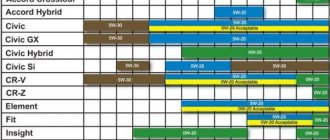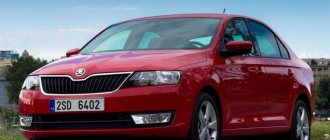Engines
The car was equipped with petrol engines with a working volume of 2.0 liters (R20A / 150 hp) and 2.4 liters (K24Z4 / 166 hp). For European Vietnam, a 2.2 CDTi diesel engine (140 hp) was also offered. In Russia, Honda SRV with a turbodiesel is very rare.
Gasoline engines have a timing chain drive. Some Honda CR-V 2007-2009 with a 2.4 liter engine with a mileage of more than 60-90 thousand km required replacement of an elongated chain. The owners were lucky to pay attention in time to changes in the sound of the engine and a decrease in traction. They managed to get by with little bloodshed. Those less attentive paid with the chain jumping several teeth and the valves meeting the pistons. To restore the engine outside of a dealer service, it took about 30,000 rubles for spare parts and 12-13 thousand rubles for labor.
Another unpleasant ailment in cars with 2.4 2007-2008 model year is chipping of the exhaust camshaft cams. The defect was discovered when the cover was opened to adjust the valves at a mileage of 120-240 thousand km. The cost of a new camshaft is 30,000 rubles. It is worth noting that there are examples that have traveled over 300,000 km without this defect.
The 2-liter unit has an incurable specific feature - an increase in vibration when the climate control is turned on. Also, on these engines there was a manufacturing defect - a violation of technology when pressing the valve guide of the third cylinder.
In general, gasoline engines are quite reliable and do not cause any trouble. The engines run easily in cold weather and have a moderate appetite. According to the regulations, valve clearance must be checked every 45,000 km. This procedure should not be neglected, since practice shows that the valves on a pair of cylinders may already “bloom” during this period.
Honda CR-V III USA (2006-2009)
On cars older than 4-5 years, there is often a need to replace oxygen sensors (λ probe). The original sensor costs about 7-8 thousand rubles, the analogue is cheaper. The catalyst “asks” for replacement after 150-200 thousand km. The original catalyst will cost 50,000 rubles, but you can save money by installing a “replacement”.
Video test drive
Honda SRV 3rd generation
Honda CR-V 2008
Interior of Honda SRV 3 2008
Honda SRV 3rd generation
You can also read a review of the 4th generation Honda CR-V
Orders for the Honda CR-V 2.4 have been accepted since the end of March 2013. Buyers have access to cars only with automatic transmissions and in four trim levels. Prices - from 1,299,000 to 1,529,000 rubles.
We liked the Honda CR-V crossover. He is focused on family values and copes with his tasks with a bang. It has a spacious and comfortable interior, a thoughtful and roomy trunk, and the suspension is a successful fusion of good handling and comfort. But the shortcomings did not go unnoticed. The slow automatic transmission did not allow the good engine to realize its potential - it was possible to drive more or less dynamically only by pushing the car with the manual gearbox. Finally, the two-liter version turned out to be not a very capable off-road fighter due to the low ground clearance and poor geometric cross-country ability. But Honda has one answer to these troubles - a CR-V with a 2.4 engine.
The Russian representative office of Honda clarifies that the main competitors for the CR-V 2.4 are Toyota RAV4, Ford Kuga, Volkswagen Tiguan and Mitsubishi Outlander. By the way, from January to April 2013, the best-selling of this list was the RAV4 - 11,410 units (+19% compared to the same period last year).
If two-liter cars have a literally outstanding front bumper, then cars with a 2.4 engine have it beveled at the bottom for better geometric cross-country ability. Useful little thing. And one more thing: a five-door with a 2.4 engine is 21 mm shorter than its two-liter counterpart (due to a different front bumper).
Such modifications are supplied to Russia from the USA, which leaves its mark. Modernized 2.4 (index K24Z), developing 190 hp. and 220 N•m (was 166 and 218, respectively), designed for the consumption of “ninety-second” gasoline. In theory, the suspension of versions 2.4 differs from the calibration of two-liter modifications in the softer springs and shock absorbers. The front bumpers are also different: for more powerful cars, the approach angle is 28 degrees versus 19 degrees for the 150-horsepower CVs. Did Honda manage to get rid of the shortcomings of cars with a 2.0 engine at once? Let's just say that we managed to correct a lot.
Transmission
Gearboxes also show good reliability. The 2-liter engine can be equipped with a 6-speed manual transmission. Owners of such cars note an extraneous sound/knock when engaging 1st and 2nd gears. These manifestations do not indicate a malfunction of the box. In any case, the box continues to function without symptoms of deterioration in “well-being.”
The five-speed automatic transmission, according to the maintenance regulations, requires an oil change with a remote filter every 45,000 km. Apparently, this is the secret of the “indestructibility” of the mechanical part of the box. But there are also weak points. These are a gear selector position sensor (2,5000 rubles) and a second gear clutch pressure sensor (2,500 rubles). The malfunction occurs on cars older than 4-5 years.
There are no serious problems with the all-wheel drive system. Except that with long runs, sometimes you have to change the driveshaft crosspieces.
Honda CR-V III (2010-2012)
Technical characteristics of CRV 5
Among the new products that Honda SRV 2021 has acquired is a newfangled one and a half liter gasoline engine with a high-pressure turbine. The specific power of the engine will be 190 horsepower with a torque of 242 nm, and it can operate with both front-wheel drive and all-wheel drive. At the same time, the car can boast of maximum torque in the rpm range from 2000 to 5000, and average fuel consumption, as shown by the test
-Honda drives will amount to 7.8 liters of gasoline in mixed mode.
Chassis
After 40-60 thousand km, the front shock absorber boots were often worn out. The cost of the boot is about 500 rubles. Shock absorbers will last more than 100-150 thousand km. An original shock absorber strut costs about 10,000 rubles, an analogue costs from 2,000 rubles. For crossovers with standard xenon lights, choosing an analogue instead of a rear shock absorber is not easy due to the design features. The rack has a mount for a ground clearance sensor.
Over 3-4 years of operation of the Honda SRV, the rear springs noticeably sag. In most cases, dealers replaced them under warranty. Honda supplied new, stronger springs. The cost of one spring is about 3-4 thousand rubles.
After 100-150 thousand km, when adjusting the wheel geometry, it often turns out that the camber of the rear wheels is outside the tolerance - the wheels are “housed”. The problem is solved by installing an upper rear adjustable arm.
After 150-200 thousand km, the silent blocks of the front and rear levers are surrendered. The rear silent blocks of the front control arms are the first to deteriorate. The cost of front levers starts from 3,000 rubles, rear ones - from 1,000 rubles. Silent blocks (from 500 rubles) can be replaced separately.
The steering rack may knock after 80-120 thousand km. The reason is wear of the right bushing. Diagnosed by tugging on the right steering rod. A new rack costs about 60 thousand rubles, a “used” one costs about 20 thousand rubles. You can get rid of the knocking by replacing the right bushing with an analogue made on a lathe from caprolon. Repairing the rack will cost 12-15 thousand rubles.
After 80-120 thousand km, the guide calipers may become sour. The repair kit will cost 2.5-3.5 thousand rubles.
Honda CR-V III (2007-2009)
Honda CR-V III generation (2007-2012)
The new car (2007-2011) became lower, wider and shorter than its predecessor, and the rear door now opened upwards, not sideways. Due to the spare wheel located under the trunk floor, the center of gravity has decreased. A feature of the Honda CR-V was the pass-through between the seats of the first and second rows and the lack of sound insulation.
HISTORY The second generation HONDA CR-V went on sale in 2001 with 2.0 liter (150 hp) and 2.4 liter (142 hp) petrol engines. which worked with “mechanics” and a 4-speed automatic. The fourth generation HONDA CR-V was produced from 2012 to 2015.
The third generation CR-V featured the latest version of the 2.4-liter K-series inline-four found in the Accord and Element. The engine output was 166 hp. at 5800 rpm, and torque - 218 N•m at 4200 rpm. In Europe, the CR-V was offered with a 2.0-litre R20A petrol engine and a 2.2-litre i-CTDI diesel engine. In the third generation, the American version of the CR-V was offered only with an updated 5-speed automatic transmission - it made it possible to achieve better efficiency indicators. The EX-L version received an integrated navigation system with voice control, XM radio, a CD radio with the ability to play MP3 and WMA files, and a 6-CD changer with a PCMCIA slot.
In 2007, the Honda CR-V entered the list of ten best-selling cars in the American market and became the most popular crossover, overtaking the Ford Explorer, which had held this title for 15 years. In Canada, the CR-V came in second, losing first place to the Ford Escape. To meet increased demand, Honda had to move production of the Civic, freeing up production capacity for the CR-V. In 2008, the Honda CR-V again became the best-selling crossover, and one of the most popular cars in the United States.
RESTYLING
The restyled version of the third generation Honda CR-V received a number of stylistic, technical and optional changes. Stylistic changes affected the front and rear bumpers, radiator grille and lights. Standard equipment on some trim levels includes 17-inch wheels, USB input and Bluetooth. Engine output has increased to 180 hp, and fuel consumption has decreased for both front-wheel drive and all-wheel drive versions.
The European version of the restyled crossover received a number of options not available in the markets of Japan, North America and Asia. These included xenon headlights, 18- and 19-inch wheels, a navigation system with GPS and DVD, a premium audio system with USB input, a panoramic roof and chrome door handles. The 2.2-liter i-CTDI N22A diesel engine was replaced with a 150-horsepower i-DTEC N22B that complies with Euro-5 standards.
Body
On models produced in 2007-2008, there are problems with the paintwork of the trunk door - small pockets of corrosion appear. Dealers painted the door under warranty. Often abrasions are found on the rear door seal, or a rubber lining “falls out” from under the chrome trim above the registration plate.
After 4-5 years of operation, the reflectors darken and the headlight glasses turn yellow. The cost of the original block headlight is about 35,000 rubles, the analogue is about 10,000 rubles. Standard xenon lasts 100-150 thousand km. An original lamp will cost 5-6 thousand rubles, an analogue - about 1.5-2 thousand rubles. Many people complain about the unsightly “jitter” of the low beam light spot. Burning of low beam lamp contacts is an officially recognized drawback of the Honda CR-V.
If there are problems with the glass washer (the liquid is supplied after 4-6 strokes), then it is necessary to replace the nozzle check valve. The cost of the valve is about 700 rubles.
In cars for the American market, malfunctions of the central locking are sometimes observed. The malfunction can be eliminated by replacing the actuator, which can be purchased from a well-known Chinese online store for 2,500 rubles.
Honda CR-V III (2007-2009)
After 4-5 years, standard parking radar sensors begin to fail. The coating on the surface of the sensor swells and “oxides” form. You can bring it back to life by cleaning and painting the surface again. Sometimes the cause of sensor “glitches” is poor plug contact. In this case, treating the junction of the contacts with conductive lubricant will help. “Officials” are asking about 5-6 thousand rubles for a new sensor.
Another recognized defect that appears on Honda SRV in the first two years of production is the activation of the electric drive of the left outside mirror when the ignition is turned on. Official services do not repair the drive, but replace the entire mirror.
Interior
The plastic interior of the Honda SRV 3 begins to creak over time. More often, “crickets” come to life with the arrival of frost. Often unpleasant sounds appear in the rear of the car. One of the reasons is the creaking of body iron from the right rear part of the car. To eliminate it, you need to remove the plastic trunk trim and treat the right side of the metal base of the body with a composition similar to WD-40, and in some places even “work” with a hammer.
Many people complain about the front passenger seat headrest rattling. The restyled versions were distinguished by play in the back of the driver's seat. Sometimes door locks and external door handle linings become the source of extraneous sounds in the cabin when driving over uneven surfaces.
Honda CR-V III (2007-2009)
The leather on the steering wheel and gear selector knob wears off after 150-200 thousand km. On cars with manual transmission, a squeaking noise appears over time when the clutch pedal is pressed. The source is the suspension bushing. Replacing it will help for a short time; a more effective method is to periodically treat the bushing with a silicone-based compound.
Equipment
With a mileage of more than 60-100 thousand km, the air conditioner may stop turning on. There are several reasons. First, a burnt out compressor relay. The original costs about 700-800 rubles. The standard relay can be replaced with a four-contact relay from Kalina/Priora for 60 rubles. Another reason is an increase in the gap between the pulley and the clutch of the air conditioning compressor and the inability to “pull”. The problem is solved by grinding off the adjusting washer to reduce the gap between the pulley and the coupling. Another reason for the air conditioner not turning on is the failure of the electromagnetic clutch. Official services charge about 12-18 thousand rubles for the coupling along with replacement. Unofficial services will require about 6-9 thousand rubles.
Some owners experience periodic flashing of the SRS system malfunction indicator. The disease is typical for cars of the first years of production. It's all about the SRS unit. A new unit is available for 30,000 rubles, and a used one for 10,000 rubles. A number of cars from the first years of production were subject to recall to replace the airbag inflator for the driver and front passenger.
After 100-200 thousand km, the voltage regulator or diode bridge of the generator may fail. Both parts cost over 1,000 rubles. Sometimes the starter also fails, but sometimes it is enough to replace the starter relay (from 800 rubles).











